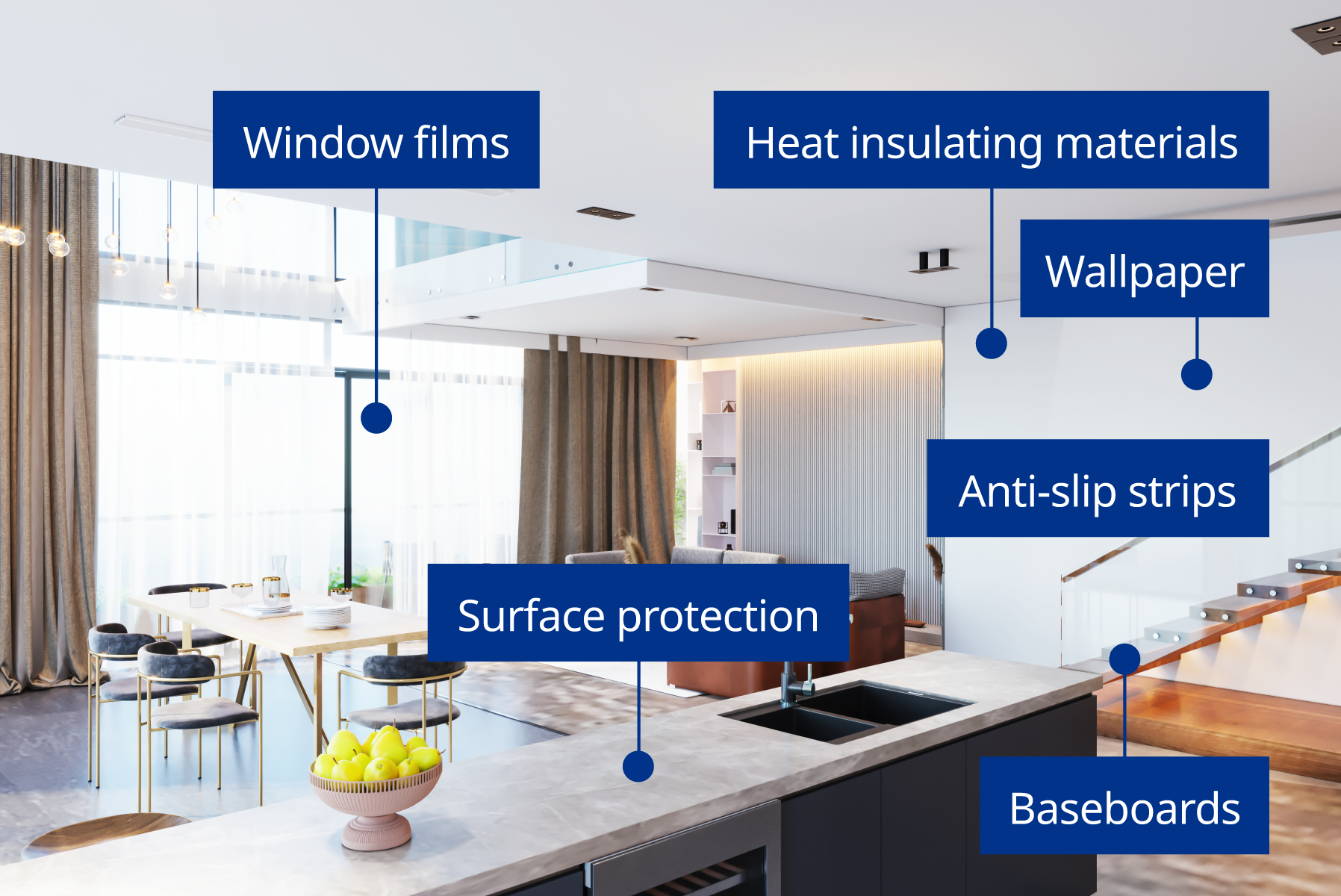SK Dyne™ | Environmentally Friendly Pressure-Sensitive Adhesive
Product Description
Soken has a diverse lineup of environmentally friendly pressure-sensitive adhesives. Our non-toluene types do not contain toluene, a common cause of sick building syndrome. We also carry high-solid types with reduced organic solvent content and biomass types that use raw materials derived from living things.
From permanent adhesive types suitable for construction materials and automotive applications to removable types for labels that can be removed cleanly after application, you can choose the material that best suits your use cases. We also have developed products with higher biomass content, so please contact us if you would like to know more.

Features
Soken's environmentally friendly adhesives come in three main types.
- Non-toluene types
- High-solid types
- Biomass types
Non-Toluene Types
Features
These pressure-sensitive adhesives do not use toluene as a solvent. Toluene is harmful to people and the environment and is also a cause of sick building syndrome. As such, it is being increasingly regulated by various national and international laws, such as REACH. Non-toluene type adhesives use solvents such as ethyl acetate instead of toluene, and we offer a lineup of products with various functionalities. Even without the use of toluene, these products offer the same wide range of functionalities as conventional products.
Applications
Tape for fixing automobile interior parts, double-sided tape, foam tape, curing tape, window film, etc.
High-Solid Types
Features
This pressure-sensitive adhesive has a reduced solvent content and a higher concentration of solids. Reducing solvents enhances the proportion of active ingredients, resulting in a highly concentrated adhesive. It enhances productivity by shortening drying times and increasing application speeds and contributes to cost savings in packaging, transportation, and storage of products. Additionally, it reduces CO2 emissions during coating drying and transport. Our lineup includes pressure-sensitive adhesives with varying degrees of adhesion, ensuring a match for any application.
Applications
Protective film, double-sided tape, foam tape, curing tape, etc.
Biomass Types
Features
These are environmentally friendly biomass type pressure-sensitive adhesives. As implied by the name, biomass refers to resources composed of organic matter. These materials are not derived from fossil fuels such as petroleum but rather from plants and animals. In fact, biomass has been gaining attention as a method to achieve carbon neutrality. Biomass raw materials are also being applied to pressure-sensitive adhesives. At Soken, we have a lineup of products ranging from permanent adhesive applications to removable applications and are making proposals and efforts to contribute to a recycling-oriented society. (Biomass types are also toluene-free.)
Applications
Anchoring flooring, securing electronic device components, curing tape, foam tape, double-sided tape, tape for securing automobile interior components, etc.
Representative Products
*Can be scrolled horizontally
| Product no. | nv (%) | Viscosity (Pa・s) | Features | |||||||||
|---|---|---|---|---|---|---|---|---|---|---|---|---|
| Adhesive strength*1 | Non-toluene*2 | High solidity | Adhesion to olefins | Stress resistance | Heat resistance | Low temperature resistance | Adhesion to rough surfaces | Plasticizer resistance | Plastic resistance | |||
| 1234DT | 44 | 7.0 | Medium | ○ | ○ | ○ | ○ | |||||
| 1273DT | 43.5 | 8.8 | High | ○ | ○ | ○ | ||||||
| 1275DT | 51 | 8.0 | High | ○ | ○ | ○ | ||||||
| 1429DT | 30 | 1.5 | High | ○ | ○ | |||||||
| 1700DT | 42 | 11.0 | High | ○ | ○ | ○ | ○ | |||||
| 1701DT | 30 | 4.5 | High | ○ | ○ | ○ | ○ | |||||
| 1717DT | 47 | 6.5 | High | ○ | ○ | ○ | ||||||
| 1720DT | 44 | 8.5 | High | ○ | ○ | ○ | ||||||
| 1838DTGB | 21 | 5.0 | High | ○ | ○ | ○ | ○ | |||||
| 1986DT | 50 | 4.5 | High | ○ | ○ | ○ | ○ | ○ | ||||
- *1 Adhesive strength is expressed in the following terms: very low, low, medium, and high.
- *2 Includes toluene at a concentration of approximately 500 ppm.
We have prepared a variety of suggestions to assist in our customers' efforts to reduce their environmental impact. Please feel free to contact us if you are interested in any of our products.
Eco-Friendly Initiatives
Environmental Initiatives
In recent years, the demand for environmentally friendly products has increased as global environmental issues have become more serious. In the chemical industry, in particular, there is a need to minimize the environmental impact of the manufacturing process and the use of products, and the pressure-sensitive adhesive market is no exception. Many conventional pressure-sensitive adhesives are solvent-based, which have a large environmental impact due to the release of volatile organic compounds (VOCs), and there is a growing awareness of the need to reduce the amount of solvents used. This section will provide an overview of environmentally hazardous substances and the need to reduce them, along with information on our adhesives with minimal environmental impact.
Types of VOCs
VOC, or Volatile Organic Compounds, are organic compound that can have a negative impact on the environment and human health. Volatility refers to the propensity to vaporize easily, which means VOCs can be released into indoor environments or the atmosphere. There is a demand to reduce VOCs because they pollute the air and pose a health hazard.
Classification of VOCs
*Can be scrolled horizontally
| Boiling point | Name | Examples of VOCs and their boiling points |
|---|---|---|
| Less than 50°C | Very Volatile Organic Compounds (VVOC) | Methane (-161°C), formaldehyde (-21°C), methyl mercaptan (6°C), acetaldehyde (20°C), dichloromethane (40°C) |
| Greater than 50°C and less than 260°C | Volatile Organic Compounds (VOC) | Ethyl acetate (77°C), ethanol (78°C), benzene (80°C), Methyl ethyl ketone (80°C), toluene (110°C), trichloroethane (113°C), xylene (140°C), limonene (178°C), l-nicotine (247°C) |
| Greater than 260°C and less than 400°C | Semivolatile Organic Compounds (SVOC) | Chlorpyrifos (290°C), dibutyl phthalate (340°C), di-2-ethylhexyl phthalate (390°C) |
| 400°C or greater | Particulate Organic Compounds (POM) | PCBs, benzopyrene |
- References: Voluntary Initiatives to Reduce Volatile Organic Compounds (VOC) in Vehicle Interiors
Japan Automobile Manufacturers Association (JAMA)
Indoor Concentration Guidelines Published by the Ministry of Health, Labour and Welfare
The purpose of setting indoor concentration guidelines is to improve the indoor environment of buildings and residences and to protect people's health. The guidelines are based on currently available chemical knowledge and are set at values that, even if someone were to be exposed to the chemical substance for their entire life, are judged to present no adverse health effects.
They inform product development and selection with the aim of creating environmentally friendly living spaces.
Indoor Concentration Guidelines (Ministry of Health, Labour and Welfare)
*Can be scrolled horizontally
| Volatile Organic Compounds (VOC) | Indoor Concentration Guidelines | Volatile Organic Compounds (VOC) | Indoor Concentration Guidelines |
|---|---|---|---|
| Formaldehyde | 100μg/㎥ (0.08ppm) |
Tetradecane | 300μg/㎥ (0.04ppm) |
| Acetaldehyde | 48μg/㎥ (0.03ppm) |
Chlorpyrifos | 1μg/㎥ (0.07ppb) Children: 0.1 μg/m3 (0.007 ppb) (0.007ppb) |
| Toluene | 260μg/㎥ (0.07ppm) |
Fenobucarb | 33μg/㎥ (3.8ppb) |
| Xylene | 200μg/㎥ (0.05ppm) |
Diazinon | 0.29μg/㎥ (0.02ppb) |
| Ethyl benzene | 3800μg/㎥ (0.88ppm) |
Dibutyl phthalate | 17μg/㎥ (1.5ppb) |
| Styrene | 220μg/㎥ (0.05ppm) |
Di-2-ethylhexyl phthalate | 100μg/㎥ (6.3ppb) |
| Para-dichlorobenzene | 240μg/㎥ (0.04ppm) |
Total Volatile Organic Compounds (TVOC) | Provisional target value 400μg/㎥ |
- Reference: On Guidelines for Indoor Air Concentrations of Chemical Substances (Ministry of Health, Labour and Welfare)
Development Background and Market Needs
Organic solvents contained in solvent-based pressure-sensitive adhesives readily evaporate at room temperature. Not only does it have an impact on the environment, but it can also have a number of effects on the human body that can lead to sick building syndrome. There is a demand for the development of environmentally friendly pressure-sensitive adhesives in various industries to solve these problems.
In particular, there is demand in the construction and automotive industries for low VOC and odorless interior materials to improve the air environment of daily living spaces. Houses have become more airtight in recent years, and without ventilation, there is a risk of insufficient air circulation in the building. The construction industry is emphasizing the importance of low VOCs to protect the health of occupants in these airtight homes. In the automotive industry, the Japan Automobile Manufacturers Association (JAMA) has published Voluntary Initiatives for Reducing VOCs in Vehicle Interiors in 2005 and has been promoting the reduction of chemical substance concentrations and odors in vehicle interiors.
For these reasons, the development of environmentally friendly, odorless, pressure-sensitive adhesives with lower VOC content is indispensable to meet market needs, and many manufacturers are currently engaged in research and development. These materials are expected to reduce environmental burden and create more comfortable living spaces.
Applications Requiring Lower VOCs in Construction Materials

Applications Requiring Lower VOCs in Automobile Interiors

Why there is demand for lower VOCs in materials for construction and automobile interiors
In the places we live and spend a lot of time, such as our homes and our cars, air quality can be negatively affected by VOCs coming from the materials used in construction and interiors.
VOCs in construction materials can cause sick building syndrome, symptoms of which include allergies and asthma. In automobiles, prolonged riding in an enclosed space can not only endanger the health of those in the car but may also lead to accidents due to negative effects on the driver's physical condition. VOCs can cause odors in the car, such as the so-called “new car smell,” and may also cause carsickness. Lowering VOCs is becoming an important issue in various industries, as it is required to protect the health of drivers and occupants, provide a comfortable indoor environment, and ensure environmental friendliness.
Other Benefits of Lowering VOCs
The less solvent in the pressure-sensitive adhesive, the higher the solids content needs to be. This results in a range of benefits beyond just reduced VOCs and the elimination of odors.
With fewer volatile components, the concentration of usable adhesive components (solid content) increases, yielding more active substances in the same volume. When transporting adhesives of the same weight, those with a higher solid content allow for a reduction in container usage and an increase in transportation efficiency compared to those with a lower solid content. Increased transportation efficiency also allows for a reduction in CO2 emissions from vehicles and ships involved in distribution. Furthermore, when applying the adhesive to a substrate and drying it, the reduced amount of volatile solvents increases coating efficiency. Thus, reducing solvent also carries an economic benefit.
Effects of Reducing Solvent

The content on this website is based on our knowledge at the time of writing. We do not guarantee the accuracy, completeness, reliability, or recency of the information provided.
- Note: The data listed are for reference only and are not standard values.
In addition, there is no guarantee that the listed uses will not infringe on any patents.
